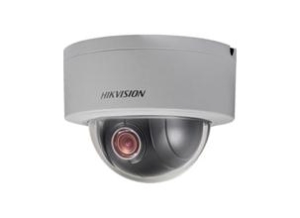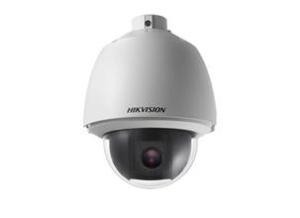Security Camera & Video Surveillance Installation in MA
Secure Lock & Alarm offers security camera and video surveillance installation to homes and businesses in Massachusetts. If you are looking to improve and enhance your home or business’s security, we can help! Our locksmith and security system professionals can enhance the safety in your home or business. Take a look below at our security camera and video surveillance installation services in Massachusetts below.
Choosing The Right Video Surveillance Components
Buying a residential or commercial video surveillance system can be much more challenging than one would think. There is a big difference between a camera purchased from a big box store and that purchased by a security professional. At first glance, the cameras may seem to offer the same functionality but educating oneself between on the varying components can save a lot of time and money.
Analog Cameras vs IP Cameras
Analog Cameras
Some analog video surveillance equipment records directly to a video tape recorder which records analog signals as pictures. When recording to a tape, the tape must run at an extremely slow speed, thus the frames per second is turned down to approximately 4 frames per second (The human eye reads at 20 fps) Therefore, analog systems are very blurry and difficult to assess. In some cases, a digital video recorder (DVR) is used which can convert analog signals to digital signals via digital capture card. Enhanced analog images get extremely blurry. The best analog camera records at .5 Megapixels an entry level IP camera records at 1.3 Megapixels.
Internet Protocol Cameras (IP)
Internet protocol refers to a digital video (IP) camera that can send and receive data via a computer network opposed to sending the feed to a video capture card on a DVR. IP digital surveillance systems record streaming at a much higher resolution than analog systems. An IP cameras system can be built with the ability for two-way radio, allow encryption and authentication, can function on a wireless network, and allow for remote accessibility. IP cameras are more expensive per camera however a single IP camera can take the place of three or four analog cameras because of wider angle viewing options. IP video management systems typically offer more flexibility and scalability than an analog system. When a traditional analog DVR set-up each camera must be wired directly to the DVR. IP cameras can circumvent this with the use of switches. There is much more flexibility with an IP system as the cameras can be moved anywhere on an IP network
Different Types of IP Cameras
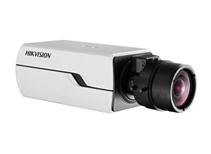
Box cameras:
Ideal for a small, specific areas where one would want to zoom in close on something. An example would be installing a box camera over a cash register or casino dealer. The focus would be so intense that one could see the serial numbers on the dollar bills and slide of hand.
Dome cameras:
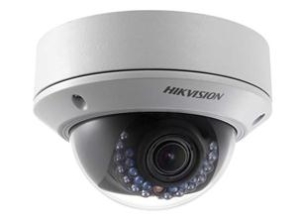 Typically used for indoor situations as they are unobtrusive and have a wide depth of field. It is very difficult to see where the dome camera is pointing so they are better for situations when they are hung in close proximity to people and run the risk of being tampered with. If used outside, dome cameras should always, always, always be installed with a camera bracket and universal bracket with pendant caps. Water and other elements will drip over the side of the bracket opposed to leak inside of the camera, thus creating a foggy picture. Dome cameras can come in two low-profile options. The recessed dome camera is ideal for drop ceilings. The Hikvision recessed dome camera lenses are the size of a golf ball, so they are very discreet.
Typically used for indoor situations as they are unobtrusive and have a wide depth of field. It is very difficult to see where the dome camera is pointing so they are better for situations when they are hung in close proximity to people and run the risk of being tampered with. If used outside, dome cameras should always, always, always be installed with a camera bracket and universal bracket with pendant caps. Water and other elements will drip over the side of the bracket opposed to leak inside of the camera, thus creating a foggy picture. Dome cameras can come in two low-profile options. The recessed dome camera is ideal for drop ceilings. The Hikvision recessed dome camera lenses are the size of a golf ball, so they are very discreet.
Bullet Cameras:
Bullet Cameras have better range and zoom capabilities than most dome cameras. Bullet cameras are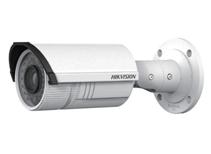 obtrusive and make it abundantly clear what is being filmed so they are typically are used outdoors and have a higher weatherproofing rating than domes cameras.
obtrusive and make it abundantly clear what is being filmed so they are typically are used outdoors and have a higher weatherproofing rating than domes cameras.
PTZ Cameras (Point-Tilt-Zoom):
PTZ cameras can be remotely controlled to look at what you want when you want to. This is different box cameras that are used for a specific location or bullet and dome cameras that need to manually adjusted to look at different areas. When purchasing a PTZ camera, consider the Optical Zoom, digital zoom, and auto pan features.
Eyeball Camera or Turret Cameras (EXIR):
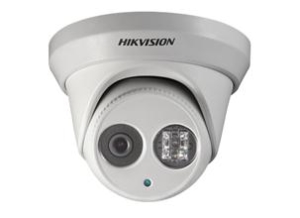 Cameras can be adjusted in 3 axis modes which means it can be mounted and then aimed. The HikVision EXIR technology, has a square lens vs. a round lens. This makes sure the IR is spread out evenly. The lens and the IR illuminator are in separate casings so there is zero chance of internal IR light bleed or reflection. Limited bleed creates an environment for even coverage. Turret domes only come in fixed lens and have a compact look. Turret cameras have fewer issues with spiders or insects which are typically attract to warmer IR light. The downside is that they only come in white and some people think they are not aesthetically pleasing.
Cameras can be adjusted in 3 axis modes which means it can be mounted and then aimed. The HikVision EXIR technology, has a square lens vs. a round lens. This makes sure the IR is spread out evenly. The lens and the IR illuminator are in separate casings so there is zero chance of internal IR light bleed or reflection. Limited bleed creates an environment for even coverage. Turret domes only come in fixed lens and have a compact look. Turret cameras have fewer issues with spiders or insects which are typically attract to warmer IR light. The downside is that they only come in white and some people think they are not aesthetically pleasing.
DIGITAL ZOOM: There are two types of digital zoom.
Motorized zoom with motorized focus. As the zoom is changed the focus will need to be adjusted as well.
Motorized zoom with auto focus. As the zoom is adjusted, the clarity of the picture will automatically re-set.
Review HikVision’s Installation Instructions Here
Lens Components:
Varifocal Lens:
The focal length, angle of view, or level of zoom can be adjusted from the NVR. Varifocal lenses are ideal for interior applications where walls are typically built at 90 degrees. A typical fixed lens will have a viewing area of 75 degrees which would leave a dead space of 15 degrees in most rooms. A varifocal lens can be set from 22 degrees (12mm) to 108 degrees(>2.8mm) in most cases, which would allow for a complete viewing area so that two cameras are not needed in this situation. Varifocal lenses typically are built with HD wide-angle viewing features so that definition can remain in-tact for longer distances. They should be used when a person needs to be identified more than 50 feet away or in situations where the cameras will be difficult to access after initial installation.
MonoLens or Fixed Lens:
One cannot adjust the focal length, angle of view, or level of zoom from the NVR. If a field of view needs to be altered, then it will need to be done at the camera. In some cases, the fixed lens cameras will physically have to be re-installed to make viewing changes. For this reason, fixed lens cameras are not ideal for outdoor usage on tall buildings. However, fixed cameras do have a wide-angle of viewing which is typically about 75 degrees. Camera lens size determines the field of surveillance and the view and zoom level that the camera provides. Fixed cameras range from 2.8mm to 100mm. The larger the size of the lens, the narrower the field of view is.
Fixed Cameras will be permanently situated at one of these distances and varifocal lens will be able to be adjusted between these ranges.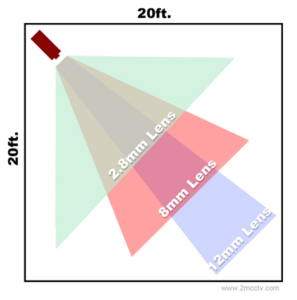
- 8 mm fixed lens will provide a 90-degree field of view
- 6 mm fixed lens will provide a 72-degree field of view.
- 6mm fixed lens offers a 43-degree field of view, a
- 12 mm fixed lens will offer a 22-degree view,
- 16mm fixed lens will offer a 19-degree field of view.
IRIS:
The Iris on the lens determines how the camera will adjust to light. There are four types; fixed, manual, auto iris, and P Iris.
Fixed Iris: Fixed iris cameras are ideal for environments with unchanging light, making them good for indoor use. These irises are preset, cannot be adjusted during installation, and are the least expensive camera option.
Manual Iris: Manual iris cameras are similar to fixed irises except they can be manually adjusted which can only be done during installation. These too are best used for indoor use with a consistent lighting situation.
High performing IP cameras uses a lens component called P-IRIS or Auto-Iris to electronically and automatically adjust to light conditions. They are programmed similar to the human eye in that they allow less light with bright situations and more light when in dark situations. When installing a camera, some contractors make the mistake of pointing a camera at the light which is similar as to the human eye looking into the sun. The camera should run parallel to the light source in order for the auto iris to function properly.
Auto-Iris also called DC Iris or Video Iris is a motorized lens that automatically adjusts according to light levels. They have the ability to adjust the iris to keep a constant video level in situations with changing lighting conditions. Ideal for outdoor situations.
P-IRIS: Precise Iris lens cameras are top of the line cameras that behave like auto-iris cameras but deliver even better image quality. These cameras have advanced software that allows for finite and motorized adjustments to react to changes in light. These cameras have technology that allow for accurate and consistent sharpness and a wide depth of view.
MEGA PIXELS VS HIGH DEFINITION (HD) CAMERAS
Any camera with a resolution of more than a million pixels is a MP camera. The lowest megapixel range is 1.3 which provides 1280 x 1024 pixel resolution. It its sometimes asked why do I need over a 2 MP camera since the monitor that I am viewing on can only see 2 megapixel. A system with 4MP cameras will record in the higher 4MP level. If the administrator is viewing the 4MP cameras on a regular monitor, then they will only able to view the images to the capabilities of the monitor which is typically 2MP. If 4MP images are viewed on the emerging 4K monitors, then they images will be viewed at the full capabilities of the cameras. A 4k monitor can see up to 8 MP. The point is just don’t buy more megapixel cameras for more megapixel sake. Money may be better spent on have a lower MP count but with Infrared or Varifocal capabilities.
HD is a subset of megapixel. HD is defined by specific resolutions at specific frames rates with a specific aspect ratio which is the width to the height of an image. HD is any camera with a standard resolution of 720 p or 1080 p which refer to horizontal resolution. A 720 P HD camera resolution provides images that are 1280 x 720 pixels or (921,600 pixels). Therefore, 720p cameras are not technically at MP camera. A 1080P HD camera provides 1920 x 1080-pixel resolution, or 2.1 MP. HD format also uses an aspect ratio of 16:9 rather than 5:4 or 4:3. Frames Per second standardization is 60, 50, 30 or 25.
FRAMES PER SECOND:
To serve as a comparison, the human eye sees 20 FPS and most mid-range commercial cameras view at 30FPS.
Focal Length:
The focal length of a camera determines what area will be surveyed in regards to width and depth. Focal length is very important where detail is a concern such as in retail stores. Cameras can be fixed at a particular range or zoom between a range from 2.8 wide angle lenses, to 3.6 mm, 4mm, 6mm, 8mm and above.
Lens Quality:
Lens quality varies from plastic to glass to low quality glass to high quality glass. There are metal bodies or plastic bodies. If the camera is primarily made of plastic, then the images will suffer.
Video Quality:
The more lines of resolution in the picture, the higher quality of picture
- Standard: Standard resolution for color cameras range anywhere from 330 TV lines to 380 TV lines
- High Resolution: Resolution ranges from 450TV lines to 480TV lines
- High Definition: Resolution ranges from 520 TV lines to 550 TV Lines
Weather Durability:
While indoor and outdoor cameras can look the same, they differ in weather durability. Cameras are built to withstand moisture and humidity, or snow and freezing temperatures, or sand and dust. Weatherproofing ratings which are referred to IP (Ingress Protection Ratings). An IP rating judges how resistant the equipment is to dust and liquids. An IP rating has two digits such as IP 65. The first digit represents protection against dust and the second number represents the protection against liquids. The higher the number the stronger the resistance is. More people are concerned with liquids vs. dust Installing dome cameras correctly by using conduit bases and brackets can reduce the chances of moisture getting inside the camera.
IP Rating Ranges
- < IP44 Indoors not intended for any water submission
- IP 44-IP66 Weather resistant and used for indoor and outdoor use under shelter
- IP66-67 Weatherproof and used for indoor and outdoor use.
- IP 68 Fully submersible and used for underwater situations.
Wide Dynamic Range (WDR):
WDR is a feature best used in IP cameras being placed a setting where there is a wide range of lighting conditions in a viewing area. WDR optimizes the level of detail in both dark and bright areas of a scene and performs advanced tone and contrast mapping.
Vandal Proofing:
A high vandal resistant surveillance camera is installed in a location where physical access to the camera is a concern: There are 3 elements that determine a vandal proof rating for an IP camera.
- The camera should be difficult to open or re-adjust. A camera can be built with recessed security screws that require a special tool to open the camera. This tool is sold with the camera and a standard screwdriver cannot be used.
- The second aspect to camera vandalism resistant is its’ impact rating which ranges from IK1 to IK10
- The third aspect is proper cabling. When camera is installed properly, it is mounted correctly and wires are not visible and less likely to succumb to wire cutters or being torn from the wall or ceiling.
Infrared (IR):
IR literally means light below red, and is light that we cannot see with our eyes. IR cameras pick up, or see, the amount of heat energy in an object has regardless of the lighting situation. IR cameras are more commonly used for commercial and industrial settings but can be used for residential situations as well. These cameras detect infrared emissions from anywhere the camera is pointed. Any warm person, animal or object emits small amounts of infrared light. An IR camera will take that heat energy and converts an electronic signal and then to a thermal image and video.
SECURITY INFRARED: IR security cameras contain a built-in IR LED array which do not require an external source of light to see a night-time image. They are factory built-in settings that detect when light drops to a preset threshold, which triggers the camera into infrared mode. IR cameras produce color images during the day and black and white images at night. The HikVision EXIR technology which can be purchased in a bullet or turret format, showcase the lens and the IR illuminator in separate casings. Cameras with EXIR technology have a square lens vs. a round lens which his makes sure the IR is spread out evenly. By the lens and the IR illuminator being in separate casings, there is zero chance of internal IR light bleed or reflection. Limited bleed creates an environment for even coverage. IR LEDs can range anywhere from 30 to 300 feet.
The quality of an infrared camera is determined by a term called lux. Lux is a term that refers to the amount of light needed to get a good picture. The lower the lux count, the lower amount of light is needed. A true infra-red camera will have a 0.0 Lux rating which means it can see in total darkness.
TRUE DAY/NIGHT CAMERAS
If darkness is a concern, then night vision day/night cameras can be purchased which have the capacity to pick up light near infrared light ranges which are not visible to the human eye. True day/night cameras take it a step further by using a very sensitive video sensor and can still produce color images in extremely low light but do not actually use Infrared. Most true/day night cameras have an IR cut filter. During the day or full light situations. The IR filter automatically sits over the lens. It filters the IR wavelengths, improving the quality of the image by showing the visible light and eliminating the harsh glow that IR can cause during full light. At night, the IR cut filter senses the light change and moves to the nighttime mode allowing for IR to be in full effect. True Day Night cameras record in color during the day and black and white at night.
Day/Night technology can pick up images in near darkness however it cannot pick up images in total darkness as IR cameras will. Keep in mind that most outside venues have some light from nearby street lamps and signs.
DIGITAL DAY NIGHT CAMERAS
DDN cameras operate in the same fashion a true day/night cameras but there is not an IR cut filter. During the day these cameras record in color and adjust electronically and offer similar benefits as the TDN cameras for much less money. At darkness the camera electronically switches to black and white viewing. The best digital day/night cameras have a very low LUX rating.
If you need to have the cameras pick up something in total and complete darkness, then you want to choose a full IR camera.

